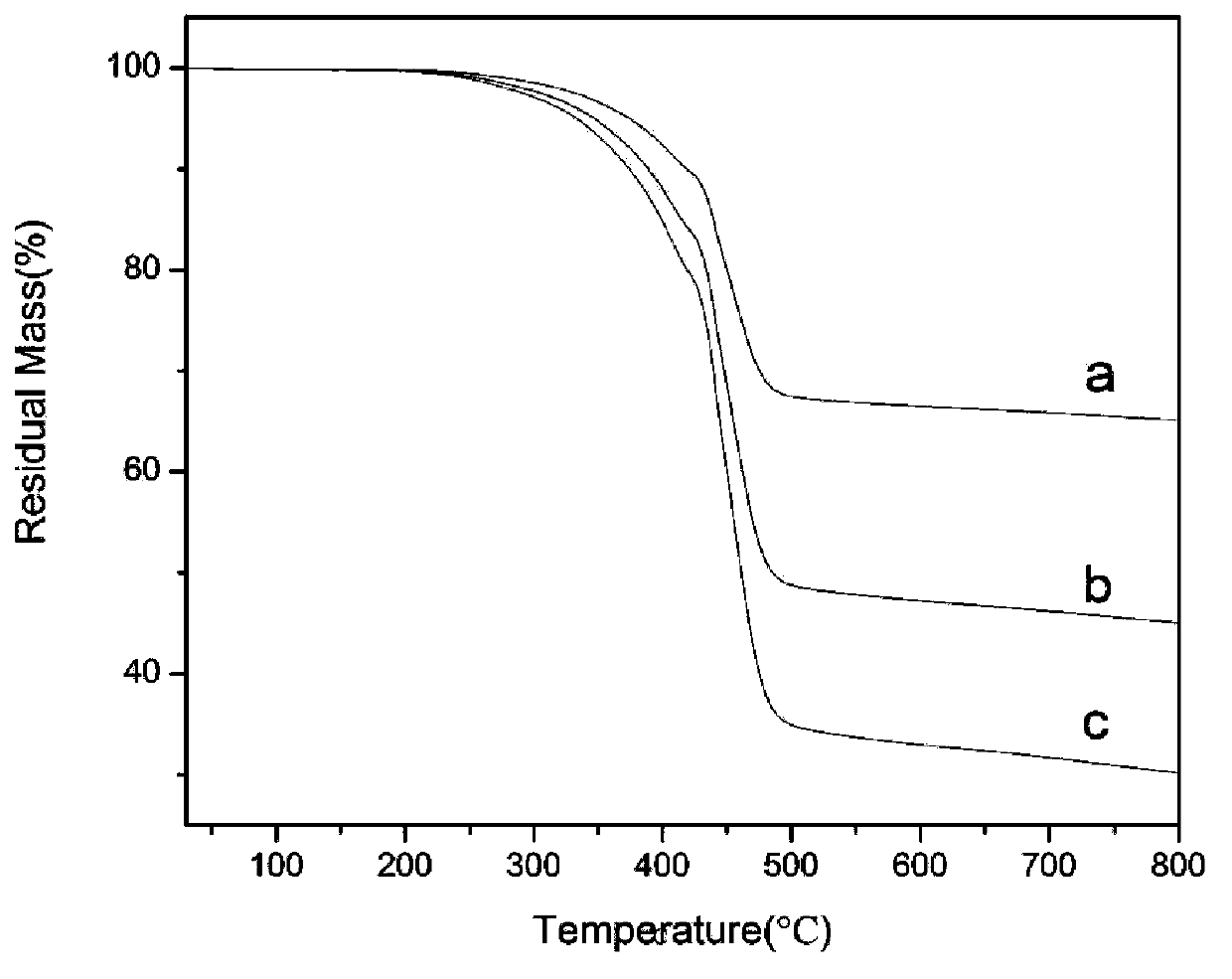Preparation method of alkynylated cardanol phenolic resin/titanium dioxide composite material
A technology of phenolic resin and composite material, which is applied in the field of preparation of alkynyl-containing cardanol-type phenolic resin and its composite material, can solve the problems of low shrinkage rate, high residual rate of pyrolysis, single element, etc., and achieves sufficient curing. , the effect of reducing the existence of bubbles and the simple preparation process
- Summary
- Abstract
- Description
- Claims
- Application Information
AI Technical Summary
Problems solved by technology
Method used
Image
Examples
Embodiment 1
[0036] 1. Preparation of Cardanol Phenolic Resin
[0037] The temperature of the water bath is controlled at 50°C, add 0.1mol (30g) cardanol, 0.085mol (2.53g) formaldehyde, and 0.002mol (0.60g) oxalic acid into a 250mL three-necked flask, stir, heat the water bath to 85°C, and react for 3.5 hours Neutralize with 0.1mol / L KOH aqueous solution to pH 7, then wash off unreacted cardanol, formaldehyde and catalyst with 1L of 50°C distilled water for 5 times, and remove the residual distilled water by rotary evaporation to obtain brown-red cardanol phenolic phenolic novolac resin.
[0038] 2. Preparation of alkynylated cardanol-type phenolic resin
[0039] The temperature of the water bath is controlled at 50°C, and 28g of cardanol-type phenolic resin prepared in step 1, 52.29g of n-butanol, and 0.08mol (4.48g) of potassium hydroxide are added to a 250mL three-necked flask, and then 0.12mol of (14.28g) 3-bromopropyne, the dropping time is controlled at half an hour, stirred, heate...
Embodiment 2
[0045] 1. Preparation of Cardanol Phenolic Resin
[0046]The temperature of the water bath is controlled at 50°C, add 0.1mol (30g) cardanol, 0.085mol (2.53g) formaldehyde, and 0.002mol (0.60g) oxalic acid into a 250mL three-necked flask, stir, heat the water bath to 85°C, and react for 3.5 hours Neutralize with 0.1mol / L KOH aqueous solution to pH 7, then wash off unreacted cardanol, formaldehyde and catalyst with 1L of 50°C distilled water for 5 times, and remove the residual distilled water by rotary evaporation to obtain brown-red cardanol phenolic phenolic novolac resin.
[0047] 2. Preparation of alkynylated cardanol-type phenolic resin
[0048] The temperature of the water bath is controlled at 50°C, and 28g of cardanol-type phenolic resin prepared in step 1, 52.29g of n-butanol, and 0.08mol (4.48g) of potassium hydroxide are added to a 250mL three-necked flask, and then 0.12mol of (14.28g) 3-bromopropyne, the dropping time is controlled at half an hour, stirred, heated...
Embodiment 3
[0054] 1. Preparation of Cardanol Phenolic Resin
[0055] The temperature of the water bath is controlled at 50°C, add 0.1mol (30g) cardanol, 0.085mol (2.53g) formaldehyde, and 0.002mol (0.60g) oxalic acid into a 250mL three-necked flask, stir, heat the water bath to 85°C, and react for 3.5 hours Neutralize with 0.1mol / L KOH aqueous solution to pH 7, then wash off unreacted cardanol, formaldehyde and catalyst with 1L of 50°C distilled water for 5 times, and remove the residual distilled water by rotary evaporation to obtain brown-red cardanol phenolic phenolic novolac resin.
[0056] 2. Preparation of alkynylated cardanol-type phenolic resin
[0057] The temperature of the water bath is controlled at 50°C, and 28g of cardanol-type phenolic resin prepared in step 1, 52.29g of n-butanol, and 0.08mol (4.48g) of potassium hydroxide are added to a 250mL three-necked flask, and then 0.12mol of (14.28g) 3-bromopropyne, the dropping time is controlled at half an hour, stirred, heate...
PUM
 Login to view more
Login to view more Abstract
Description
Claims
Application Information
 Login to view more
Login to view more - R&D Engineer
- R&D Manager
- IP Professional
- Industry Leading Data Capabilities
- Powerful AI technology
- Patent DNA Extraction
Browse by: Latest US Patents, China's latest patents, Technical Efficacy Thesaurus, Application Domain, Technology Topic.
© 2024 PatSnap. All rights reserved.Legal|Privacy policy|Modern Slavery Act Transparency Statement|Sitemap

